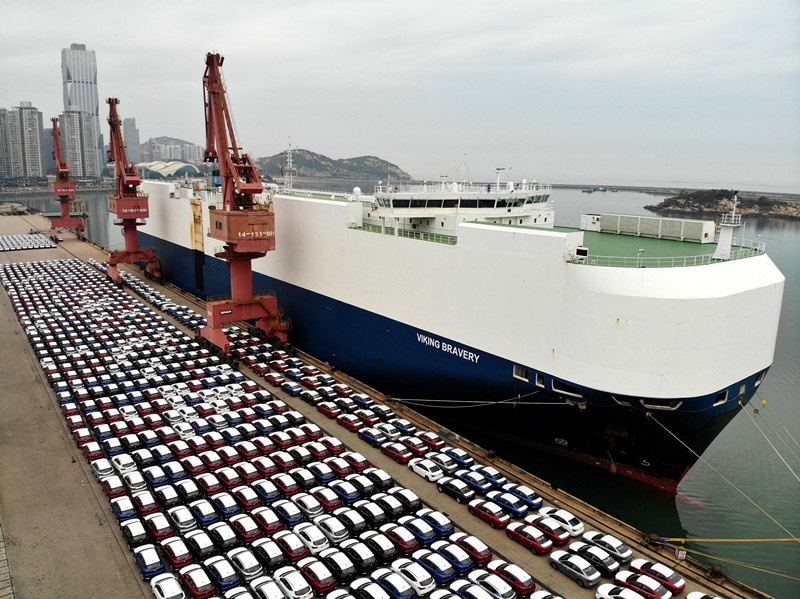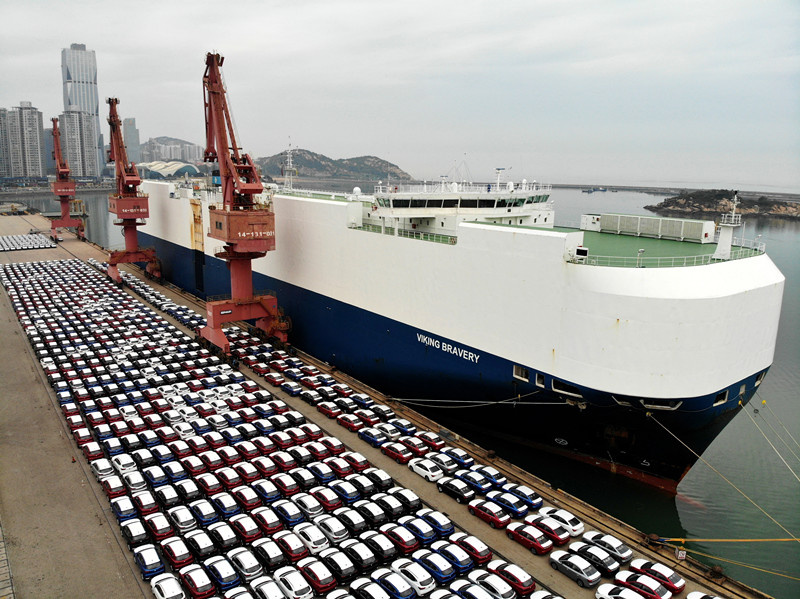By Ouyang Jie, Luo Shanshan, People’s Daily

Photo taken on Oct. 11 shows an ocean-going ro-ro ship gets ready to export over 1,500 automobiles overseas at a wharf in Lianyungang Port of Lianyungang city, east China’s Jiangsu province. (Photo by Wang Chun/People’s Daily Online)
In the past five years, China has unswervingly expanded opening-up, worked faster to bring domestic systems and rules in line with international ones, opened its door wider to the world and continued to raise the level of opening-up.
The country has put into effect the foreign investment law across the board to safeguard the legitimate rights and interests of foreign investors, successively cut tariffs, taken the initiative to expand imports, accelerated institutional innovations and promoted higher-standard opening-up.
China has eased market access in more areas. On Sept. 2, Citibank (China) Co., Ltd. announced that it had received a domestic fund custody license from the China Securities Regulatory Commission, China’s securities regulator, and became the first American bank to be granted such a license.
“We are pleased to participate in and play a steady role in the reform and development of China’s financial markets. This license is further validation of China’s commitment to continue opening up its financial markets,” said Stuart Staley, head of Markets and Securities Services, Citi Asia Pacific.
Since 2018, China has notably accelerated the opening of its financial sector, as the People’s Bank of China and the China Banking and Insurance Regulatory Commission have successively announced and promoted the implementation of more than 50 specific opening-up measures. The financial sector is an epitome of the country’s efforts to relax controls on market access and attract foreign investment.
During the “13th Five-Year Plan” period (2016-2020), China has rolled out the foreign investment law and the regulations regarding its implementation, which established the system of pre-establishment national treatment plus a negative list in legal terms and canceled across the board the approval and filing procedures for the establishment and change of foreign enterprises.
The country has revised its negative lists for foreign investment market access for four consecutive years, cutting the restrictive measures to 33 from 93, and granting national treatment to foreign investors.
Last year, China rolled out a new version of the catalog of industries that encourage foreign investment, which contains 1,108 items, including 415 items for encouraging foreign investment nationwide.
The new catalog for encouraging foreign investment nationwide has 67 newly-added items and 45 modified items compared with the 2017 version, continuing to expand the investment scope for foreign investors.
Meanwhile, China has innovated trade models to promote higher-standard opening-up. On Sept. 1, 1,081 air humidifiers produced by Guangdong Titan Smart Electrical Appliances Co., Ltd. were shipped abroad from the logistics park of the bonded logistics center in Zhongshan city, south China’s Guangdong province.
“The customs’ program for cross-border e-commerce B2B export allows us to directly export goods to overseas warehouses, greatly shortening the time for customs clearance and cutting logistics costs,” said the company’s chairman Li Hui.
Since July 1, ten regional customs directly under China’s General Administration of Customs, including Beijing, Tianjin, and Nanjing, have piloted a supervision model to boost cross-border e-commerce B2B export. So far, 22 customs have been added to the pilot program.
Under the new supervision model, e-commerce B2B exporters are given support in various forms, including streamlined procedure, expedited clearance, customs transit, and prior inspection.
In the first half of 2020, the value of imports and exports transacted online by cross-border e-commerce enterprises exceeded 600 billion yuan (about $89.7 billion), up by 6.7 percent. New business models such as cross-border e-commerce are constantly creating new drivers for the development of the country’s foreign trade.
China has also adopted measures such as boosting the rapid development of new types of foreign trade, hosting China International Import Expos, cutting tariffs, and deepening reform in integrated customs clearance procedures.
During the 13th Five-Year Plan period, China has steadily improved the quality of its foreign trade by optimizing the business environment at ports, taking the initiative to open up its market and expand imports, and promoting the innovative development of foreign trade.
With a total foreign trade volume of goods of 31.54 trillion yuan, the country remained the world’s largest trader in goods in 2019.
This year, China has become a bright spot in the gloomy global trade despite the severe impact of the COVID-19 epidemic. The country’s total foreign trade volume of goods reached 20.05 trillion yuan in the first eight months, down 0.6 percent year on year. The drop narrowed by 1.1 percentage points compared with the decline from January to July.
By making opening-up a catalyst for reform and development, China’s opening-up has gathered stronger momentum.
In the Lianyungang area of China (Jiangsu) Pilot Free Trade Zone (FTZ) in east China’s Jiangsu province, goods are loaded to ships in an orderly manner.
As the country’s first demonstration port of rail-sea intermodal transport services of containers, the Lianyungang area has initiated models such as mix containers of bonded and export products, and direct vehicle services and shipping with zero waiting time for customs supervision, which effectively improved the traffic efficiency of international freight trains.
China has also advanced in-depth market-based reforms with high-standard opening-up. In August 2019, the country launched six pilot FTZs in Shandong, Jiangsu, Guangxi, Hebei, Yunnan, and Heilongjiang provinces, as well as the new Lingang area of the China (Shanghai) FTZ.
In September 2020, the country released a master plan for three new pilot FTZs in Beijing, Hunan province and Anhui province, and adopted a plan to expand the pilot FTZ in Zhejiang province.
During the 13th Five-Year Plan period, China has newly added 17 pilot FTZs, bringing the number of its pilot FTZs to 21, which expanded from the coastal provinces to central, northeast, northwest, and southwest China.
China’s more FTZs with higher quality demonstrate its new endeavors for opening-up and its confidence and determination to respond to external challenges through efforts to expand opening-up.
The country has put into effect the foreign investment law across the board to safeguard the legitimate rights and interests of foreign investors, successively cut tariffs, taken the initiative to expand imports, accelerated institutional innovations and promoted higher-standard opening-up.
China has eased market access in more areas. On Sept. 2, Citibank (China) Co., Ltd. announced that it had received a domestic fund custody license from the China Securities Regulatory Commission, China’s securities regulator, and became the first American bank to be granted such a license.
“We are pleased to participate in and play a steady role in the reform and development of China’s financial markets. This license is further validation of China’s commitment to continue opening up its financial markets,” said Stuart Staley, head of Markets and Securities Services, Citi Asia Pacific.
Since 2018, China has notably accelerated the opening of its financial sector, as the People’s Bank of China and the China Banking and Insurance Regulatory Commission have successively announced and promoted the implementation of more than 50 specific opening-up measures. The financial sector is an epitome of the country’s efforts to relax controls on market access and attract foreign investment.
During the “13th Five-Year Plan” period (2016-2020), China has rolled out the foreign investment law and the regulations regarding its implementation, which established the system of pre-establishment national treatment plus a negative list in legal terms and canceled across the board the approval and filing procedures for the establishment and change of foreign enterprises.
The country has revised its negative lists for foreign investment market access for four consecutive years, cutting the restrictive measures to 33 from 93, and granting national treatment to foreign investors.
Last year, China rolled out a new version of the catalog of industries that encourage foreign investment, which contains 1,108 items, including 415 items for encouraging foreign investment nationwide.
The new catalog for encouraging foreign investment nationwide has 67 newly-added items and 45 modified items compared with the 2017 version, continuing to expand the investment scope for foreign investors.
Meanwhile, China has innovated trade models to promote higher-standard opening-up. On Sept. 1, 1,081 air humidifiers produced by Guangdong Titan Smart Electrical Appliances Co., Ltd. were shipped abroad from the logistics park of the bonded logistics center in Zhongshan city, south China’s Guangdong province.
“The customs’ program for cross-border e-commerce B2B export allows us to directly export goods to overseas warehouses, greatly shortening the time for customs clearance and cutting logistics costs,” said the company’s chairman Li Hui.
Since July 1, ten regional customs directly under China’s General Administration of Customs, including Beijing, Tianjin, and Nanjing, have piloted a supervision model to boost cross-border e-commerce B2B export. So far, 22 customs have been added to the pilot program.
Under the new supervision model, e-commerce B2B exporters are given support in various forms, including streamlined procedure, expedited clearance, customs transit, and prior inspection.
In the first half of 2020, the value of imports and exports transacted online by cross-border e-commerce enterprises exceeded 600 billion yuan (about $89.7 billion), up by 6.7 percent. New business models such as cross-border e-commerce are constantly creating new drivers for the development of the country’s foreign trade.
China has also adopted measures such as boosting the rapid development of new types of foreign trade, hosting China International Import Expos, cutting tariffs, and deepening reform in integrated customs clearance procedures.
During the 13th Five-Year Plan period, China has steadily improved the quality of its foreign trade by optimizing the business environment at ports, taking the initiative to open up its market and expand imports, and promoting the innovative development of foreign trade.
With a total foreign trade volume of goods of 31.54 trillion yuan, the country remained the world’s largest trader in goods in 2019.
This year, China has become a bright spot in the gloomy global trade despite the severe impact of the COVID-19 epidemic. The country’s total foreign trade volume of goods reached 20.05 trillion yuan in the first eight months, down 0.6 percent year on year. The drop narrowed by 1.1 percentage points compared with the decline from January to July.
By making opening-up a catalyst for reform and development, China’s opening-up has gathered stronger momentum.
In the Lianyungang area of China (Jiangsu) Pilot Free Trade Zone (FTZ) in east China’s Jiangsu province, goods are loaded to ships in an orderly manner.
As the country’s first demonstration port of rail-sea intermodal transport services of containers, the Lianyungang area has initiated models such as mix containers of bonded and export products, and direct vehicle services and shipping with zero waiting time for customs supervision, which effectively improved the traffic efficiency of international freight trains.
China has also advanced in-depth market-based reforms with high-standard opening-up. In August 2019, the country launched six pilot FTZs in Shandong, Jiangsu, Guangxi, Hebei, Yunnan, and Heilongjiang provinces, as well as the new Lingang area of the China (Shanghai) FTZ.
In September 2020, the country released a master plan for three new pilot FTZs in Beijing, Hunan province and Anhui province, and adopted a plan to expand the pilot FTZ in Zhejiang province.
During the 13th Five-Year Plan period, China has newly added 17 pilot FTZs, bringing the number of its pilot FTZs to 21, which expanded from the coastal provinces to central, northeast, northwest, and southwest China.
China’s more FTZs with higher quality demonstrate its new endeavors for opening-up and its confidence and determination to respond to external challenges through efforts to expand opening-up.
 Menu
Menu
 China continues to open its door wider to the world
China continues to open its door wider to the world
















